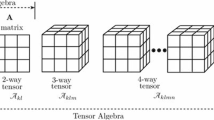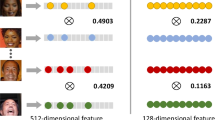Abstract
In the field of face recognition, sparse representation based classification (SRC) and collaborative representation based classification (CRC) have been widely used. Although both SRC and CRC have shown good classification results, it is still controversial whether it is sparse representation or collaborative representation that helps face recognition. In this paper, a new singular value decomposition based classification (SVDC) is proposed for face recognition. The proposed approach performs SVD on the training data of each class, and then determines the class of a test sample by comparing in which class of singular vectors it can be better represented. Experimental results on Yale B, PIE and UMIST datasets show that the proposed method achieves better recognition performance compared with several existing representation based classification algorithms. In addition, by adding Gaussian noise and Salt pepper noise to these datasets, it is proved that SVDC has better robustness. At the same time, the experimental results show that the recognition accuracy of the method acting on the training samples constructed by each class is higher than that of the method acting on the training sets constructed by all classes.








Similar content being viewed by others
References
Akhtar N, Shafait F, Mian A (2017) Efficient classification with sparsity augmented collaborative representation. Pattern Recogn 65:136–145
Basri R, Jacobs DW (2003) Lambertian reflectance and linear subspaces. IEEE Trans Pattern Anal Mach Intell 25(2):218–233
Boyd S, Parikh N, Chu E, Peleato B, Eckstein J (2011) Distributed optimization and statistical learning via the alternating direction method of multipliers. Found Trends Mach Learn 3(1):1–122
Cai S, Zhang L, Zuo W, Feng X (2016) A probabilistic collaborative representation based approach for pattern classification. In: IEEE Conference on Computer Vision and Pattern Recognition, pp 2950–2959
Chi Y, Porikli F (2014) Classification and boosting with multiple collaborative representations. IEEE Trans Pattern Anal Mach Intell 36(8):1519–1531
Chien JT, Wu CC (2002) Discriminant waveletfaces and nearest feature classifiers for face recognition. IEEE Trans Pattern Anal Mach Intell 24(12):1644–1649
Deng W, Hu J, Guo J (2018) Face recognition via collaborative representation: Its discriminant nature and superposed representation. IEEE Trans Pattern Anal Mach Intell 40(10):2513–2521
Georghiades AS, Belhumeur PN, Kriegman DJ (2001) From few to many: illumination cone models for face recognition under variable lighting and pose. IEEE Trans Pattern Anal Mach Intell 23(6):643–660
Graham DB (1998) Characterising virtual eigensignatures for general purpose face recognition. The Book: Face Recognition Form Theory to Applications, pp 446–456
He K, Zhang X, Ren S, Sun J (2016) Deep residual learning for image recognition. In: IEEE Conference on Computer Vision and Pattern Recognition, pp 770–778
Lan R, Zhou Y, Liu Z, Luo X (2020) Prior knowledge-based probabilistic collaborative representation for visual recognition. IEEE Trans Cybern 50 (4):1498–1508
Lin G, Yang M, Yang J, Shen L, Xie W (2018) Robust, discriminative and comprehensive dictionary learning for face recognition. Pattern Recogn 81:341–356
Liu W, Chawla S, Bailey J, Leckie C, Ramamohanarao K (2012) An efficient adversarial learning strategy for constructing robust classification boundaries. In: Proceedings of the 25th Australasian Joint Conference on Advances in Artificial Intelligence, pp 649–660
Liu S, Wang Y, Peng Y, Hou S, Wu X (2020) Singular value decomposition-based virtual representation for face recognition. Mach Vis Appl 31(3):1–9
Naseem I, Togneri R, Bennamoun M (2010) Linear regression for face recognition. IEEE Trans Pattern Anal Mach Intell 32(11):2106–2112
Selvan S, Ramakrishnan S (2007) Svd-based modeling for image texture classification using wavelet transformation. IEEE Trans Image Process 16 (11):2688–2696
Shao C, Song X, Feng ZH, Wu X, Zheng Y (2017) Dynamic dictionary optimization for sparse-representation-based face classification using local difference images. Inf Sci 393:1–14
Sim T, Baker S, Bsat M (2004) The cmu pose, illumination, and expression database. IEEE Trans Pattern Anal Mach Intell 25(12):1615–1618
Slawski M, Hein M (2013) Non-negative least squares for high-dimensional linear models: consistency and sparse recovery without regularization. Electron J Stat 7:3004–3056
Song X, Feng ZH, Hu G, Kittler J, Wu X (2018) Dictionary integration using 3d morphable face models for pose-invariant collaborative-representation-based classification. IEEE Trans Inf Forensics Secur 13(11):2734–2745
Wright J, Ganesh A, Yang A, Zhou Z, Ma Y (2011) Sparsity and robustness in face recognition: A tutorial on how to apply the models and tools correctly, arXiv:1111.1014, pp 1–12
Wright J, Yang A, Ganesh A, Sastry SS, Ma Y (2009) Robust face recognition via sparse representation. IEEE Trans Pattern Anal Mach Intell 31(2):210–227
Xu J, An W, Zhang L, Zhang D (2020) Sparse, collaborative, or nonnegative representation: which helps pattern classification?. Pattern Recogn 88:679–688
Yin HF, Wu X, Feng ZH, Kittler J (2020) Affine non-negative collaborative representation based pattern classification. 2007.05175
Zhang L, Yang M, Feng X (2011) Sparse representation or collaborative representation: Which helps face recognition? In: International Conference on Computer Vision, pp 471–478
Zhang G, Zou W, Zhang X, Hu X, Yong Z (2017) Singular value decomposition based sample diversity and adaptive weighted fusion for face recognition. Digital Signal Process 62:150–156
Zhang G, Zou W, Zhang X, Yong Z (2018) Singular value decomposition based virtual representation for face recognition. Multimed Tools Appl 77 (11):7171–7186
Acknowledgements
This work is supported by the National Natural Science Foundation of China (Grant No. 61906098).
Author information
Authors and Affiliations
Corresponding author
Additional information
Publisher’s note
Springer Nature remains neutral with regard to jurisdictional claims in published maps and institutional affiliations.
Rights and permissions
About this article
Cite this article
Long, X., Zhang, Z. & Li, Y. A singular value decomposition representation based approach for robust face recognition. Multimed Tools Appl 81, 8283–8308 (2022). https://doi.org/10.1007/s11042-022-12199-2
Received:
Revised:
Accepted:
Published:
Issue Date:
DOI: https://doi.org/10.1007/s11042-022-12199-2




